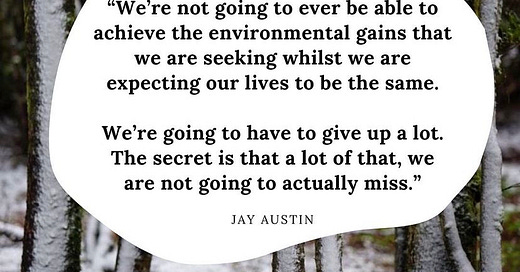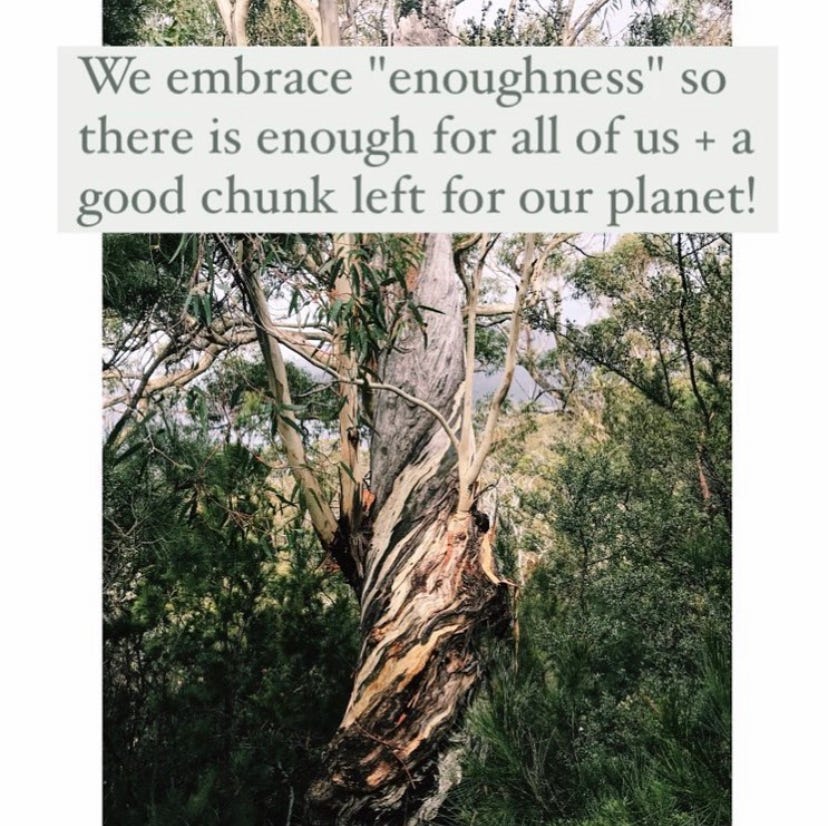Part 2 - Enoughness in the building industry // A movement towards what matters
As promised here is part 2 - "A home is meaningless without the moments and memories it holds"
You may like to go back and read Part 1 of this series before you read this - it will make more sense!
It can be very complicated, trying to do the right thing, trying to lessen your impact and save the planet whilst upholding your way of life, making a living, being relevant, climbing the ladder and finding a position in the world. Then add considerations of operational energy, star ratings, U-values, membranes, carbon life cycle, thermal bridging, air exchanges, heat recovery, offsets.
It's a lot to consider. I know.
But pretty quickly I realized that it doesn't need to be that stressful or complicated. We are just making it hard and complicated because we are trying to change without changing.
We are trying to lessen our impact without changing how we’re living, what we want and what we’re willing to use to get there. We are trying to lessen our impact whilst having more, bigger and better.
We are trying to change without changing. Here is that quote from Jay Austin again as a reminder:
How about we just consider what's enough?
It's actually very simple - embrace enoughness and just use less.
But we know - simple is not the same as easy.
The one most powerful thing we can do to slow the ruining of this planet is to just use less. This action alone reduces energy use and thus carbon emissions. But how do we do this? How do we just use less and be satisfied with enough, when we live in a system that is constantly telling us to want more?
If we are to transition to a renewable energy system whilst the rate of growth and consumption continues as it is, we are filling a bath without putting in the plug.
The amount of energy needed to produce the renewables and then produce the stuff we use and buy is still growing despite our transition efforts.
The problem isn't our carbon emissions. This is a symptom of the problem.
The real problem is that we consume too much and this consumption uses a heap of energy.
As Jason Hickel says, our way of life and obsession with growth and stuff is “metabolizing the natural world.” You can delve deeper into what Jason Hickel thinks here:
We are at a point in time when we need to be thinking about our choices and how this affects others and the planet. And, a way we can do this is by asking new and honest questions.
Our homes are where our lives are centred and where we can start, by considering them as a vessel for creating change. Our homes are where values are formed and held, where we rejuvenate and dream about our life and our future. They shape our habits and affect how we feel, they support us to go out into the world and do great things.
More energy efficient buildings are necessary. But what we need are people unsubscribing to a consumerist way of living, asking new questions and embracing enoughness, not just in their homes, but everywhere. We need more people living and satisfied with enough.
When I told the Undercover architect that enoughness is:
“working out what you need to be happy and healthy without taking more than your fair share”
That last bit, “fair share” triggered some people.
Fair enough. I don't want to shame anyone because it's not our fault. And I'll explain why in a bit.
The research also shows we’re not getting any happier.
There was a time not that long ago when we spent 90% of our time outside in our natural environment. We were part of it and it was a part of us. Over only a few hundred years we are now spending 90% of our time inside and our relationship with our environment has been broken, fragmented, and the reciprocity has been forgotten. We are taking, not only more than we need or that we can give back, but far more than the earth can replenish.
Why?
It's human nature to seek happiness, comfort and freedom. But I would suggest we are looking to find this in the wrong places.
Who told us that big houses, kitchen appliances and ‘stuff’ was going to make us happy and fulfilled?
And who is willing to say that this constant striving for more, bigger and better isn't making us happy or healthy?
If stuff and things and houses are not the things that we need to strive for to bring us happiness and fulfilment then what will?
Time, connection and relationships are the things that bring us true happiness and fulfilment. The good news is that these are all freely available to the privileged world, and they don’t cost us a cent.
Enoughness can give us more of what we really need for happiness, health and fulfilment and as designers and creators, we can play a significant and inspiring role in bringing this to our work, to our clients and the world.
The other good news is that enoughness doesn't always mean having less, sometimes it's about having more. And we are at a time where we are craving more. More connection, more time, more nature and more meaning.
So what is enough?
The definition of enough is:
“In or to a degree or quantity that satisfies, or is sufficient or necessary for satisfaction”
And herein lies a problem. Our satisfaction.
We can't seem to be satisfied. Or is it that we are trying to satisfy ourselves with the wrong things? things that are actually taking away our happiness and health and demolishing the planet at the same time.
Do we even know what satisfies us?
It seems we are trying to satisfy ourselves with things, achievements and wealth, but it now seems clear that it's not working. We don't need these things to be happy and healthy. The things we need to be healthy and happy are free and not things at all. They are connections. Connection to others, nature, our purpose and ourselves.
And the less things we have in our lives to cling onto, take care of and pay for the more time and space we have for these truly meaningful things that are satisfying our human spirit.
Less financial burden creates space in our lives for time to cultivate our values and tend to our connections and most meaningful actions.
We seem to be striving to fill the void with things that increase our wealth but also our financial burden and one of these things is often our home.
“The cost of anything is the amount of life we are willing to exchange for it.”
We all know the phrase ‘dream Home’ but what do we really mean by that?
Images will come to mind, we see them every day in magazines on Instagram and in ads. It seems in our area of work that success is to deliver what looks like the ‘dream home’ We feel this expectation in our bones every damn day.
But is it really a ‘dream home’ if we are maxed out financially and have to work more and longer hours, if we feel guilty about not spending quality time with our children, if we reduce our time for connection and doing things we like to do? All with an added feeling of having to keep our ‘dream home’ clean and well presented?
I like to rephrase the ‘dream home’ to the ‘dream lifestyle’. Because when I spend time talking with clients about this, what they really value is an ideal lifestyle that is aligned with their values. After all, it is no good having the ‘dream home’ if you can't have a lifestyle that aligns with who you are.
Our homes are a good place to start when considering what's enough for us to be happy, connected and well. They are our life base, holding us, providing us with shelter and safety.
What if we change our perspective and shift the value of our home from a symbol of wealth, status and ‘the ultimate in design’ to being about providing shelter, warmth, a place to eat, connect and carry out the ceremony of life?
If this were their function would we design them differently? Would, what they look like matter as much as it does right now?
After all, a home’s true purpose is as a vessel for living.
“A home is meaningless without the moments and memories it holds”





